
Volunteer Waivers: Should You, or Shouldn’t You?
Whether or not to use volunteer waivers is a popular topic cropping up in our VolunteerPro Insiders group on Facebook, especially as we all continue to navigate through COVID-19 and the pandemic. I’d like to address in this article what kinds of things should we be asking about from our volunteers, what our waiver does for your organization, and how to best make decisions about whether or not you need a volunteer waiver in the time of COVID-19.
First, a Waiver on Volunteer Waivers.
The caveat here is that I am not a law attorney. This discussion is not supposed to replace legal advice.
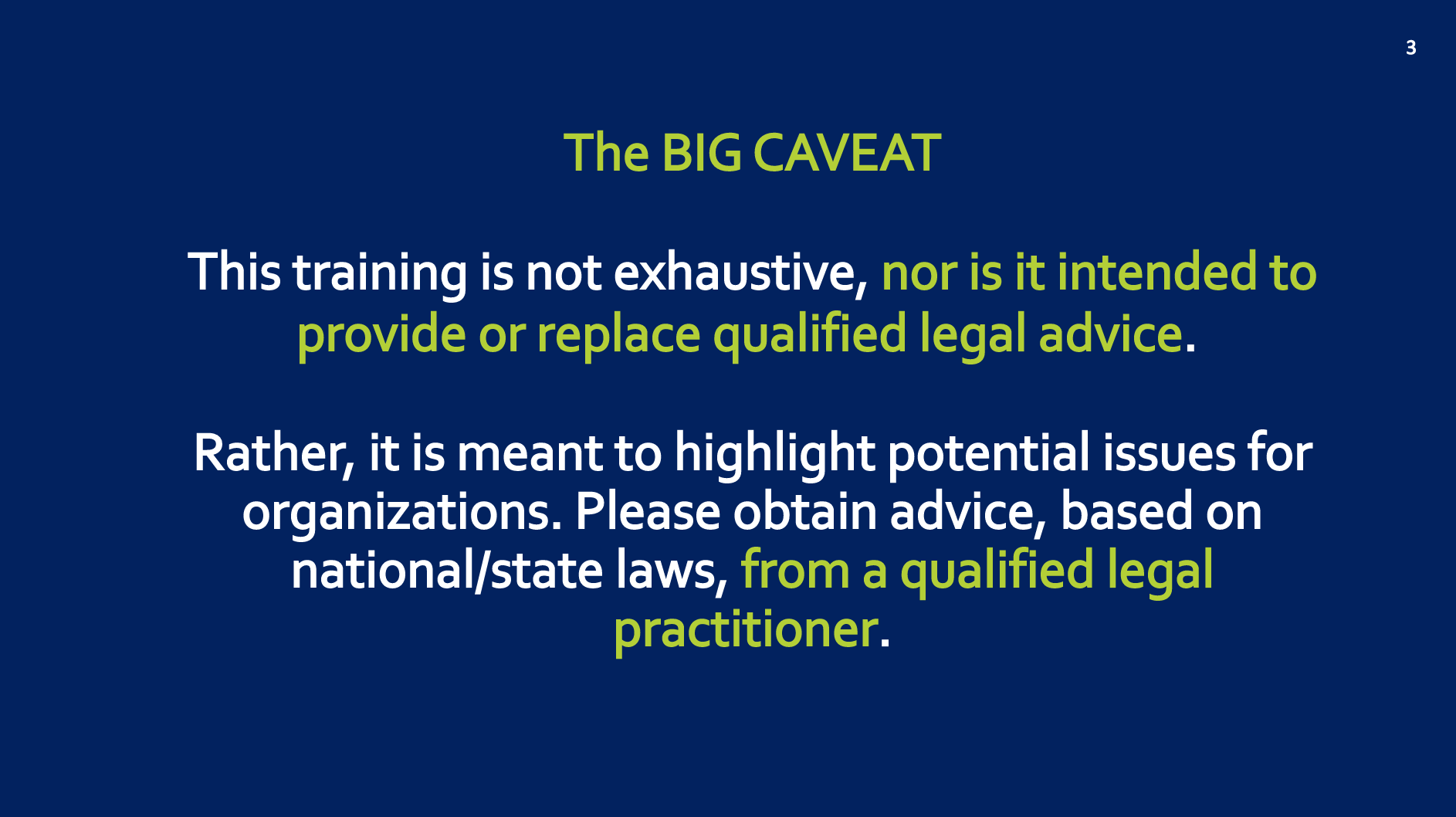
Any time you create a contract where you want someone else to sign and give away something they own (including their rights) – that’s what volunteers do when they sign a waiver – then you should have your agency’s attorney look it over.
This article is will help you start to think about whether or not you need a waiver. But it is not intended to replace qualified legal advice.
The Purpose of Volunteer Waivers
I’m often struck often by misunderstandings about what waivers are and what they can actually do for you and your organization.
Some believe they protect volunteers. Others that they can ensure specific compliance.
While volunteer waivers or agreements are helpful in communicating expectations, they do not protect volunteers, nor guarantee people follow guidelines.
Rather, it’s helpful to think of waivers as a risk management tool.
There are four basic options for managing risk in your organization.
How We Can Manage Risks
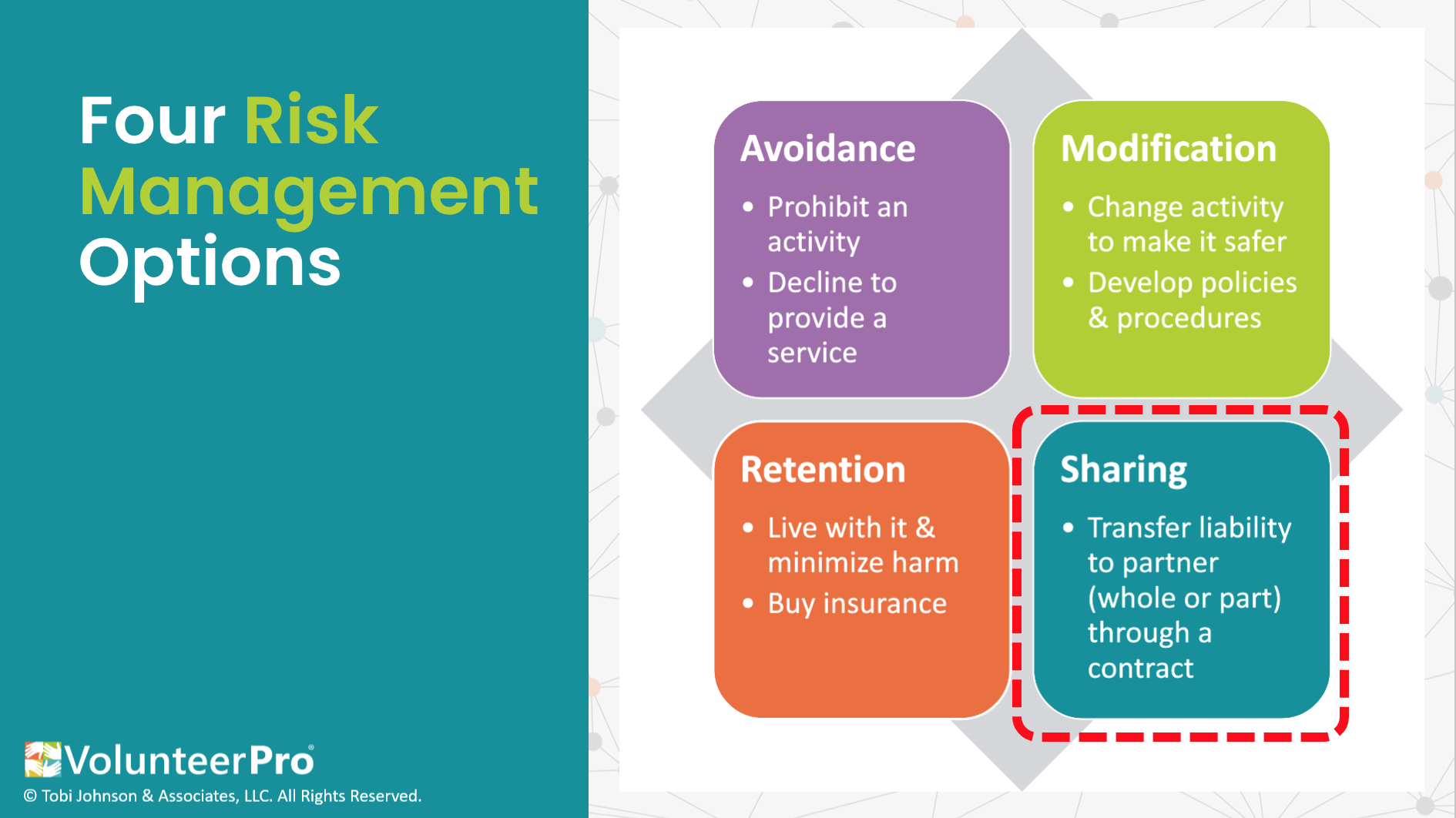
1. Avoid Risk Entirely
This is what many have been doing with volunteers during the pandemic. Groups have decided either a) not provide the service, or b) not have volunteers come down to their brick-and-mortar right now. In other words, to avoid risk.
Avoiding risk altogether makes sense in many contexts, especially given CDC guidelines around COVID-19, and the rapid rise in transmission rates here in the US.
2. Modification
Another way to manage risk is to change an activity in order to make it safer. In addition, to develop policies and procedures that describe these modifications. For example, changing up how volunteers interacting with your organization when they return to on-site service might be a modification. Establishing social distancing guidelines is a modification, as well as implementing staggered schedules so there are fewer volunteers during each shift.
Further, establishing protocols for taking temperatures and reporting medical symptoms, or disclosing whether they’ve been around someone else who’s tested positive for COVID-19, is also a modification. Having people wear PPE is another example.
Any time you change an activity or set it up to keep it safe you are using modification as a risk management strategy.
3. Buy Insurance
Some amount of risk is inherent in most human activity. So, often organizations decide to live with it and buy insurance as a backstop.
While it covers paid employees, worker’s compensation insurance usually doesn’t cover volunteers. However, other insurance can be purchased to cover supporters or others who visit your facilities.
Check with your insurance policy if you’re unclear about how your organization’s insurance may or may not cover volunteers. Now is a good time to ask questions, and be clear on coverage, before you begin to bring people back in.
4. Volunteer Waivers
While insurance may sometimes help you, it often doesn’t cover volunteers.
You may need to rely on the fourth way of managing risk, which is through transferring liability to a partner in whole or part through a contract.
This is, for all intents and purposes, what a volunteer waiver is.
Before implementing one, it’s important to be completely clear on what a waiver is. People have different ideas about what these documents achieve. They are also unclear about who they serve, as well as what you’re asking volunteers to do when you ask them to sign.
To explain – in short, a waiver transfers the responsibility of liability from one party to another. When you have a volunteer sign a waiver, they are essentially saying, “I am holding your organization harmless for any harm that might come to me during my service.”
Also, depending on what you specify in your waiver, it can be very specific. For example, “I agree to hold the organization harmless for a disease transmission,” like COVID-19.
Adult volunteers can decide whether or not they want to sign. For volunteers under the age of 18, their parent or guardian must agree and sign in their stead.
Goals of Volunteer Waivers
So, what is the goal of having a contract like this? If your agency is not clear on why volunteer waivers are being used, then don’t use them,

Make sure you understand why your agency requires volunteer waivers, as well. The rationale should not be “because others are doing it and it sounds like a good idea.”
1. Protection
Liability protection and risk management are the top reasons to use a waiver. Waivers are intended to protect organizations, but they do not necessarily prevent lawsuits.
The waiver is intended to protect your organization. It’s not to protect anybody else, including the volunteers.
2. Enforce Compliance
In addition, waivers can also be used to enforce compliance.
There is a limit to how much protection a waiver can offer, however. There is some debate in the legal field as to whether waivers actually stand up in court very often.
So, you may also want to include in your waiver how any dispute will be negotiated. Talk to your lawyer and ask if a volunteer waiver is worth the paper it’s written on and how you can establish alternatives to court when there is a grievance.
3. Documentation
Another use for a waiver to mark the time when a volunteer becomes official, in other words, the official date and time when the volunteers sign up.
In the US, the Volunteer Protection Act and other state laws are intended to protect a volunteer from liability when performing service on behalf of a charity or cause. Other countries also usually have similar statutes specific to volunteers.
You may establish that once they sign, they are considered an active volunteer. This also helps mark the time when the Federal Volunteer Protection Act and other Good Samaritan laws will start to cover the volunteer. If there were to be a lawsuit against the volunteer, you are able to provide concrete documentation proving the date, they became officially authorized by your organization.
But remember, your waiver does not protect volunteers. It protects your organization. If you’re concerned about protecting volunteers, be clear that this avenue is not going to protect them.
That said, you can use a waiver to mark a time when the volunteer was appointed. If anything happens after that date, and they are actively logged in and authorized to be performing work on your behalf, their protection is through federal and local volunteer statutes active in your jurisdiction.
4. Inform Volunteers
Finally, waivers can also help you inform volunteers, ahead of time, on rules and guidelines. It can also document volunteer commitment to following those rules.
In the end, however, it is the proper training and supervision of volunteers that will ensure compliance, long after volunteers have signed the waiver (and have forgotten what was included in it).
And, as noted above, you can use a waiver to inform volunteers on how a dispute might be settled if they experience wrongdoing and want to arrive at a solution.
Another Caveat on Volunteer Waivers
Also, waivers do not ensure, nor guarantee the productivity and performance of volunteers. That is not what the contract is for. Nor does it expressly protect their safety and wellbeing. Your waiver may give volunteers some comfort and confidence. It’s an opportunity to clearly state -here’s our protocol.”
But, be clear that wavers do not do the job, the heavy lifting, of protecting them.
Wishful people in organizations will want these waivers because they think somehow the waiver offers a blanket of security for everyone.
But waivers are not as powerful, and they might not even be a work in a court of law. The bottom line? It’s important to
- Know what you are trying to have with a contract of this kind and
- Talk to your attorney about whether this tool makes sense.
Psychological Contracts
The other limitation of a waiver is that it doesn’t address other kinds of agreement and understandings, like the “psychological” contract.
A waiver is a paper contract or electronic contract between people, but there’s also, another kind of contract at play in these relationships – a psychological contract between volunteers and organizations.
A psychological contract represents an often unspoken agreement between people and organizations; in other words, what people think the other side promised to them when they began to collaborate.
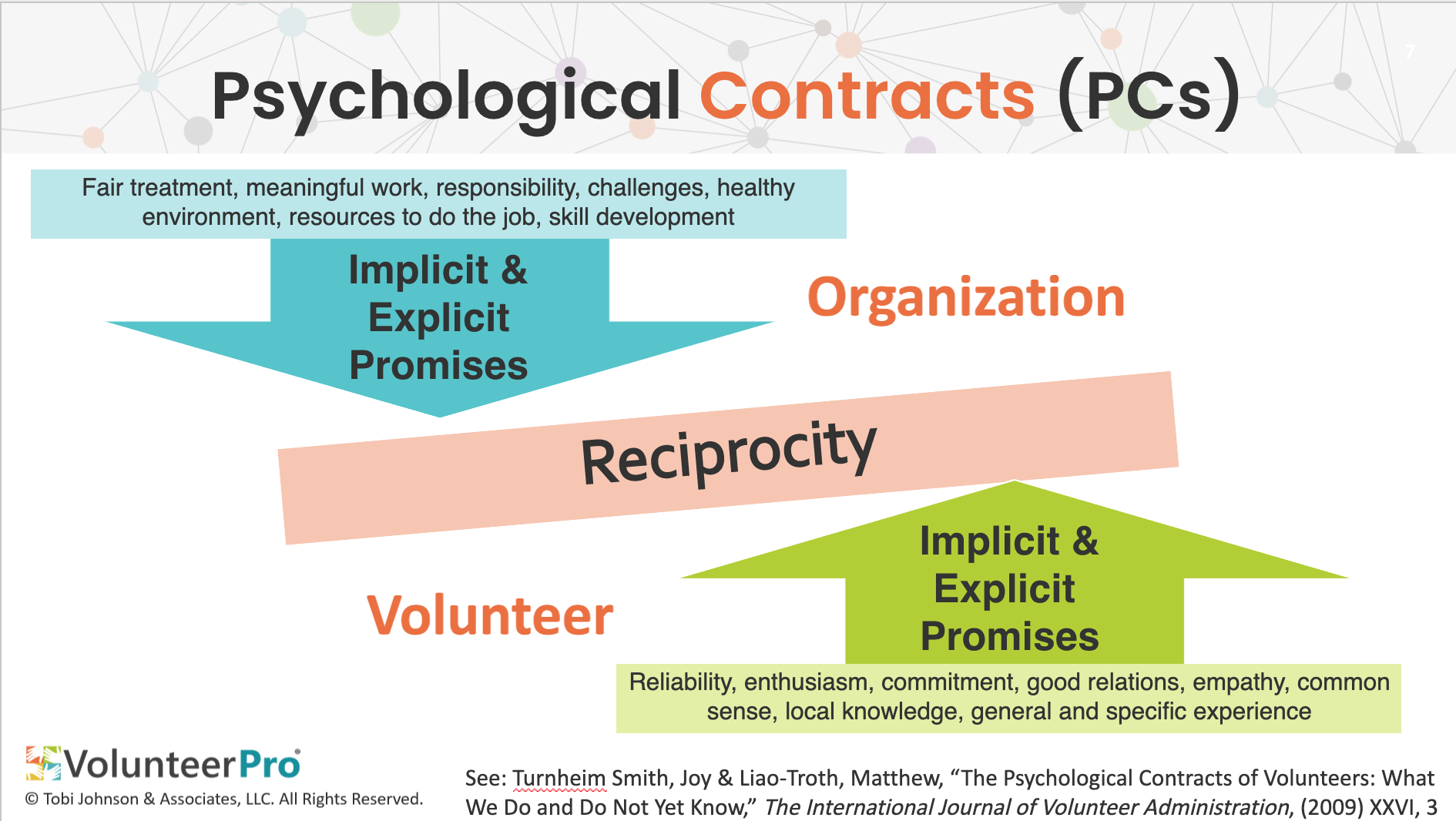
They can be either implicit and explicit — implicit when we believe someone has promised something to us, but it was not promised verbally or in writing and explicit when we have received concrete communication.
These perceptions are formed from both sides, the volunteer expects things from the organization, and the organization expects things from the volunteer.
The biggest problem is that psychological contracts are often unspoken and unclear. Often organizations will be explicit about volunteer requirements – “We need you to do this much training. We need you to track your hours. We need you to just submit to a background, check, etc. But those are not where the real psychological contract issues arise. The real psychological contract issues are deeper than that. They’re about feelings and emotions.
Volunteers might expect of organizations: fair treatment, meaningful work, responsibility, challenges, healthy environment, resources to do the job skill development opportunities. They might also, they might also expect that you give them the benefit of the doubt.
When you ask someone to sign a waiver, Volunteers may perceive that your organization is not giving them the benefit of the doubt.
You’re saying, for all intents and purposes, we think some of you might engage in a lawsuit against us. Therefore, we want you to ensure and promise that you will hold us harmless.
Organizations also have implicit promises that they’re at asking for from a volunteer: They want reliability, enthusiasm, commitment, relations, empathy, common sense, local knowledge, general, and specific experience. They also might want volunteers to follow guidelines and safety rules. Again, a waiver does not necessarily ensure that people follow all of the rules and it may not the best way to go about encouraging compliance. Above all else, psychological contracts are based on the idea of mutual reciprocity. And when one side thinks the other side hasn’t followed through on a promise, even when they never talked about it, it causes a breach.
Anyone who’s ever been in a conflict with a partner where you believe they “should have known” your needs (e.g. read your mind) knows what a psychological contract breach feels like. In contrast, a volunteer waiver does not create a relationship of mutual expectations and commitments. That said, it can be used to surface some of the unspoken promised that comprise psychological contracts. That is if you put them in writing.
Vounteer Waivers vs. Volunteer Agreements
A volunteer waiver is also different than a volunteer agreement.
Volunteer agreements can be used to share the organization’s expectations, values, and principles for our volunteers. They may also include agreements to safety guidelines as well as be used to make implicit promises explicit.
They may specify volunteer grievance procedures. But they are not a waiver because if you’re not asking people to hold you harmless from liability, then that’s not a waiver. So, organizations have options.
What a Hold Harmless Waiver May Communicate to Volunteers
Hold harmless waivers may communicate implicit messages to volunteers that create a negative experience., It depends on the nature of service and how intense and risky it is.
We now know from public health data how pervasive the Coronavirus is in certain areas, how many people have died, whether the transmission rates are going up or down, how many new transmissions, and new people with COVID in an area. . But we don’t know it all. Because we don’t have wide-scale testing, we can’t predict the level of risk.
So, when you ask volunteers to serve in person, in some respects you are asking them to put their life and health on the line. And, because we know the virus has long-term consequences, you’re asking them to roll the dice on their future health, too.
Consider the requirements for a volunteer waiver that might be perceived in this context.
Your agency is telling volunteers – if you do put your health on the line, we want you to know that you can’t hold us liable. You can’t, hold us responsible for anything you do to help us move this mission forward. And at the same time, we understand that you have put yourself on the line. But that’s just one message.
In some cases, volunteers become angry if they are not allowed to make their own decisions” about their service.
The bottom line is the need for your agency to think through the optics of volunteer waivers and the messages they send to volunteers in your context. And you must decide for yourself if this matters or not At the end of the day, the ultimate responsibility for the safety of everyone involved in supporting an organization is the organization.
And it’s up to the organization to decide which methods can best achieve that goal.
Will volunteer waivers be part of the picture? Maybe so.
But they should not be your only solution.
Ready for a More Resilient 2021? Get Tips to Survive and Thrive with Our Free Guide
Looking for a pick-me-up to get you through tough times? Download our Free Guide and read about how talented volunteer leadership professionals overcome challenges, stay motivated, stay positive, and have fun, even when faced with a crisis.
You will leave with 20 tips that will keep you inspired and energized, giving you the ability to lift your community with you as you focus on what you are here to do: build a thriving support system for your nonprofit!
[FREE GUIDE] 20 Top Tips from Leaders of Volunteers: How to Survive and Thrive During Times of Crisis
26 pages of inspiration from leaders who walk the talk.
Learn what your peers have to say about the following four themes:
- Overcoming Challenges: You can do Hard Things
- Mindfulness: Good Vibes Only
- Stay Motivated & Do Good Work
- Be Yourself: Have Fun and Make a Difference


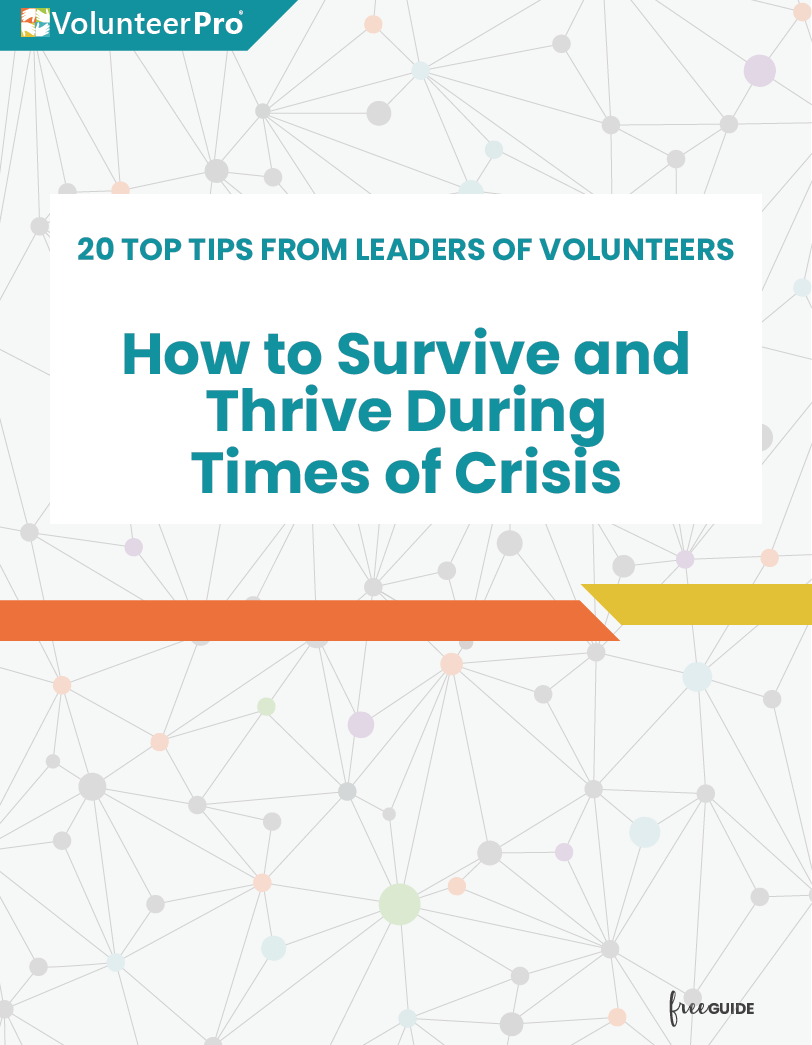

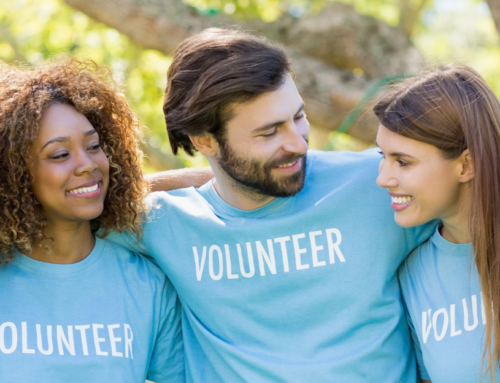



Leave A Comment